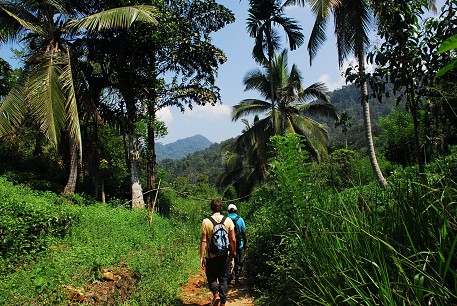 The island in the Indian Ocean has white beaches, fascinating temples and the Sinharaja Forest. There you can search for snakes and swim in the waterfalls.
The island in the Indian Ocean has white beaches, fascinating temples and the Sinharaja Forest. There you can search for snakes and swim in the waterfalls.
The little worm has hit its suction cup to the skin at the ankle. The skin bleeds now in bright-red blood. The feet slip away because the stones are overgrown with plants. Sweat runs down my face. First, the shirt on the back gets wet, then under the arms and finally the belly. The lungs, it seems, are not pumping in enough oxygen due to the moisture. The legitimate question to pose at this moment: what the hell is a human being doing here?
There are places in Sri Lanka, after all, that are more pleasant than the last primeval lowland rain forest. Those who fly to the teardrop-shaped island in the Indian Ocean mostly want to see Buddhist temples or the white beaches on the south coast. The resorts in Hikkaduwa, Mirissa and Weligama are well-trimmed holiday paradises under a tropical sun.
Deniyaya, a town located less than 100 miles to the north, is damp and musty: the monsoon has left its mark at the facades of the houses, the clouds hang heavy in the sky. It is not far from here to the Sinharaja Rain Forest, which the UNESCO declared, in 1988, as a world heritage site due to its biological diversity.
Tourists do not need a permit to visit the nature reserve. About 15,000 visitors per year are daring to embark on this adventure. It goes without saying that the tourist do not go alone into the rain forest: the Singhalese Bandula Rathnayaka accompanies them. In 1994, his brother Upali started to invite tourists from the street to make a guided tour with him through the jungle. This developed into a solid business.
In the morning, the tuk-tuk struggles to drive up the torn up street to the entrance of the national park. The day is sweltering hot. Sixty metres high trees are visible in the distance. About 20 villages are at the fringes of the nature reserve. The people are allowed to explore the approximately 29,650 acres large conservation area as long as they are not felling any trees. Nobody lives in the deep rain forest.
The machete is crushing down on a coconut, the milk runs out. Bandula offers the sweet drink to his guests. Then, he catches a centipede that curls up in his hand. The 55-year-old with his turquoise polo shirt and the worn sneakers knows every fruit and every plant.
Where the National Park begins, it is darker and noisier. Through the branches is almost impossible to see the sky. Birds, insects and monkeys are singing, chirping and shouting through the trees. It is even moister here. It is here that you get a notion what rain forest really means: the primitive state of the world.
The orientation is difficult now, but Bandula knows the way as well as the botanical names of the plants. Two-thirds of the tree and plant species in the park are endemic, meaning that they only exist in this place in the world. What is more, there are many unique species of birds, mammals and amphibians. Of the king of the forest, the leopard, only a few specimens are left.
"Look up there, a purpled-faced leaf monkey," says Bandula. We can spot the monkey only when it moves. A kangaroo lizard sits on a tree stump, but is also hard to recognise. Bandula then reaches into the bush and shows us a long-nosed whip snake. The snake shines in neon green colour. "It is only slightly poisonous," says Bandula.
Less fascinating, however, are the hundreds of leeches sitting on the stones and sticking immediately on the shoes if one stops, crawling to the next spot of free skin and adhering themselves tightly there. They are unpleasant but not dangerous: "I have been bitten a 1,000 times and I am still alive," says Bandula. He reveals the trick how to get rid of the animals of the shoe: tear them off, roll them between your fingers like gum wrappers and then flick them off.
Those who are walking with Bandula through the jungle get quickly the impression to be in a giant chemist's shop. The Singhalese cuts on a liana and encourages me to taste it. "It tastes bitter but helps against tetanus." Then he puts a leave into his mouth. "Good for the stomach." A snail is sitting on a rock: its bitter venom acts as a painkiller for the ears. The animal is therefore called "doctor snail", explains Bandula. It is now that one becomes fully aware what the cutting of the rain forests really means.
The largest rain forests in the world—in the Amazon area, Congo Basin and Indonesia—have been shrinking for years.
On the banks of a river, my shirt is completely soaked with sweat. Suddenly there is a rushing river to be heard. Over a rock ledge a waterfall goes down four metres to a natural basin in the riverbed. It is time for a plunge. The water is cool and clear; colourful butterflies are fluttering over my head through the sparse sunlight. As soon as we get out of the water, the real rain starts. The precipitation looks like mist; it goes like a dense grey veil through the five vegetation levels of the evergreen rain forest. The drops are tearing up the dry soil. There is no other noise to be heard except the falling rain. After the spectacle is over, the clouds opens up and the sun rays refracted in tens of thousands of water droplets of the rising steam.
Source: Rheinische Post, 11 August 2012, By Philipp Laage